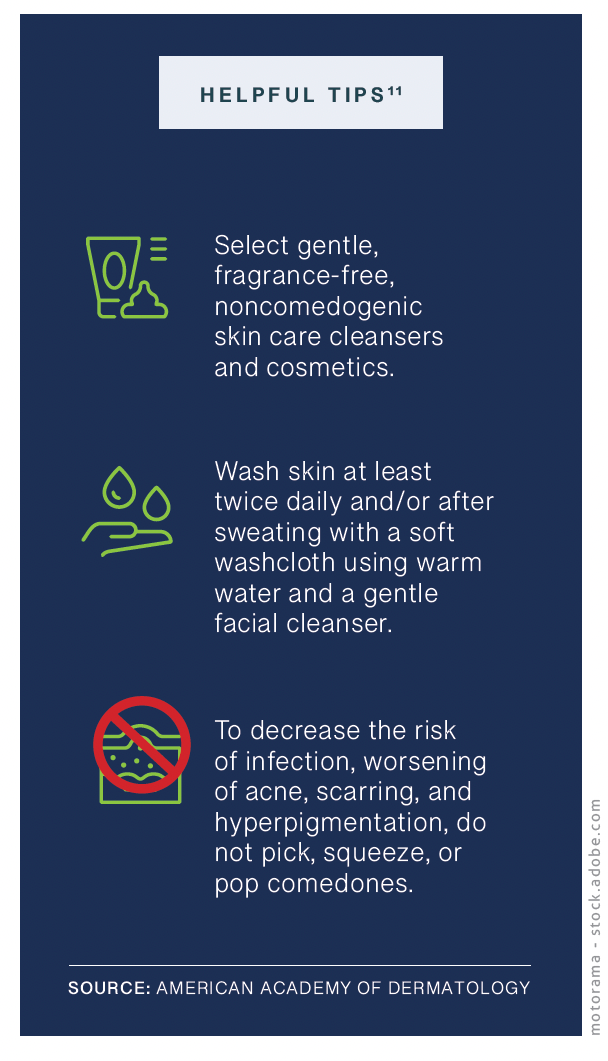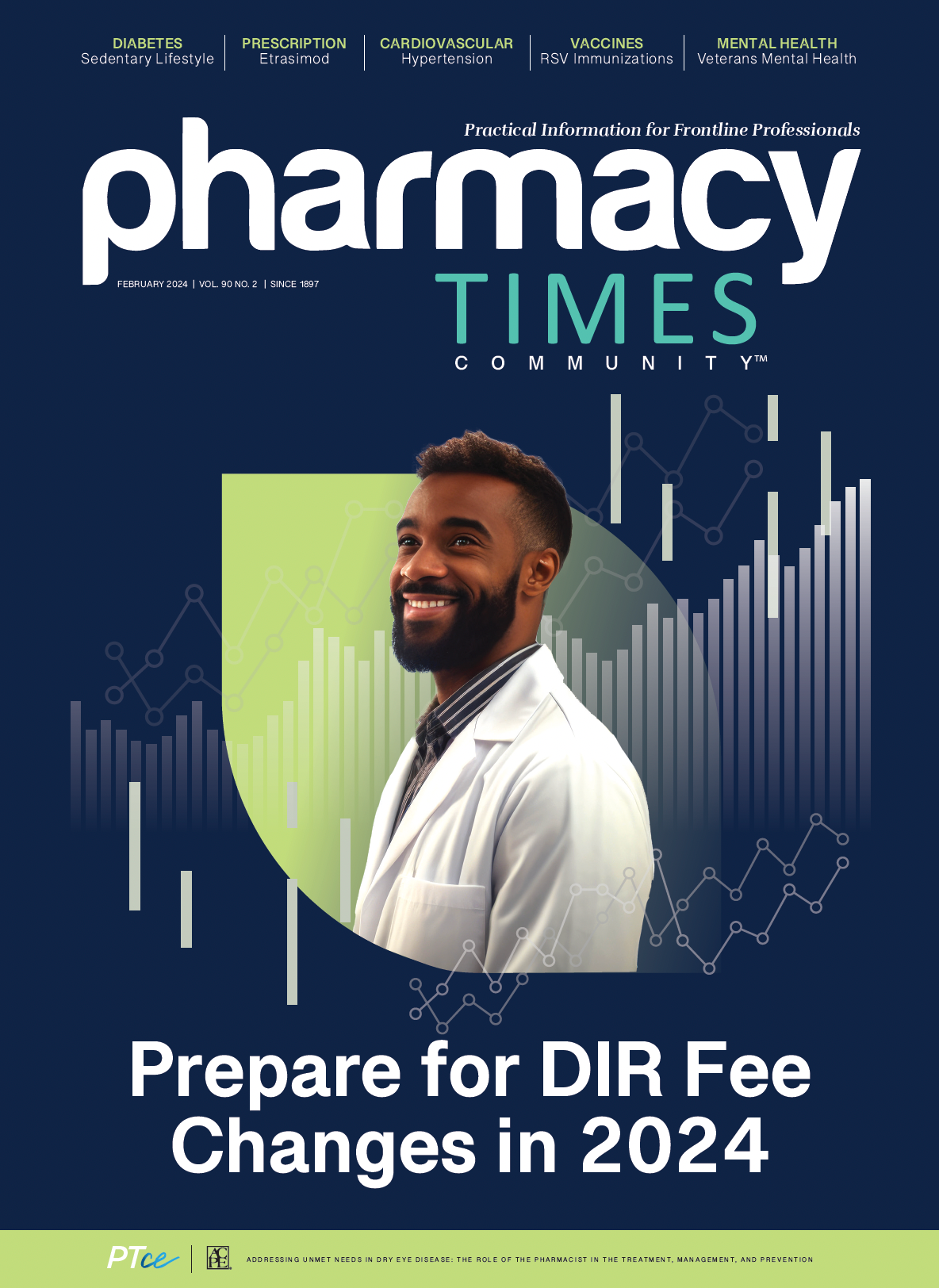Publication
Article
Pharmacy Times
Self-Care Measures Can Help Prevent, Treat Acne
Author(s):
With a wide array of OTC products, pharmacists can help patients select the right regimen
Acne vulgaris is one of the most common dermatological conditions and presents in varying degrees of severity.1 The American Academy of Dermatology indicates that acne affects an estimated 50 million individuals in the United States, with more than 85% of cases occurring in individuals between the ages of 12 and 24 years, but it can occur at any age.1 Research indicates that 80% of Americans experience some degree of acne during their life.
Image credit: Jacob Lund | stock.adobe.com

Although acne vulgaris is considered an inflammatory dermatological condition resulting from follicular hyperkeratosis, increased sebum production, and the follicular proliferation of Cutibacterium acnes (Propionibacterium acnes), imperfections in the epidermal barrier also play a critical role in its pathogenesis.1-3 The etiology of acne is often multifactorial, which contributes to the formation of inflammation and open and closed comedones (commonly known as whiteheads and blackheads), papules, pustules, nodules, and/or cysts. It can be the result of several factors such as hormonal changes during pregnancy, menstruation, perimenopause, or menopause; genetics; and environmental causes (eg, exposure to excess ultraviolet radiation, excessive sweating due to heat, occlusive clothing such as hats, oil-based cosmetics, and repetitive mechanical trauma caused by scrubbing affected skin with harsh soaps and detergents).2-6 Examples of other factors that may contribute to or exacerbate acne include using certain pharmacological agents (eg, corticosteroids, some anticonvulsant medications, lithium, and isoniazid) and medical conditions (eg, polycystic ovarian syndrome and thyroid issues).4,6 Some studies also suggest that excessive stress can exacerbate acne.6
Pharmacists are well positioned to guide patients in selecting topical medications marketed for treating and preventing mild to
moderate acne. Available topical OTC products include 0.1% topical adapalene gel (approved by the FDA in July 2016 as a topical nonprescription retinoid product for acne); topical benzoyl peroxide, which is available in concentrations ranging from 2.5% to 10%; keratolytic acids, including α-hydroxy acids and β-hydroxy acids; salicylic acid in concentrations ranging from 0.5% to 2%; as well as sulfur and sulfur/resorcinol products.3 Study results have shown that benzoyl peroxide and adapalene are the most effective OTC treatments for acne.3
Because these products are available in a variety of formulations, the selection of appropriate products should be tailored to each patient’s needs, taking into account their preferences, skin type, and severity of acne. The American Academy of Dermatology’s guidelines for managing acne with regard to topical therapies state, “Therapy choice may be influenced by age of the patient, site of involvement, extent and severity of disease, and patient preference. Topical therapies may be used as monotherapy, in combination with other topical agents, or in combination with oral agents in both initial control and maintenance.”7
Although the majority of acne cases are amenable to selftreatment, pharmacists should direct patients with severe acne or those not responding to the use of OTC acne products to seek further medical evaluation from a dermatologist.
RECENT NEWS AND CLINICAL DATA
In a recent issue of Scientific Reports, authors sought to explore the correlation between acne vulgaris and patient self-esteem and quality of life (QOL). The authors discovered that acne and the associated psychological distress had a considerable negative effect on patients’ self-esteem and QOL.8 They also noted the findings demonstrated the need to identify and address both the physical and emotional facets associated with acne, which may improve overall well-being and QOL.8
Results of another study, published in Archives of Dermatological Research, revealed that more than 70% of patients with acne wait at least 1 year before consulting a dermatologist. The study also found that patients most opt to use OTC acne treatments.9
In a recent study published in the Journal of Drugs in Dermatology, the use of dermocosmetic products containing salicylic acid was an effective adjunctive therapy to benzoyl peroxide for acne treatment.10 Additionally, the use of dermocosmetics as a maintenance therapy post benzoyl peroxide yielded a considerable decrease in the relapse of acne, and participants required less frequent use of benzoyl peroxide.10

CONCLUSION
During counseling, pharmacists should remind patients that adherence to the selected treatment regimen and routine skin care are integral to improving clinical outcomes. Patients should also be informed about treatment goals and expectations, proper administration, and recommended daily applications, and that therapeutic effects may take weeks before improvements become apparent. Patients should also be educated about potential adverse effects and discuss any concerns with their dermatologist or primary health care provider, especially if they are experiencing skin irritation, excessive skin dryness, or hypersensitivity issues.
About the Author
Yvette C. Terrie, BSPharm, RPh, is a consulting pharmacist and medical writer in Haymarket, Virginia.
References
- Skin conditions by the numbers. American Academy of Dermatology. Accessed December 21, 2023. https://www.aad.org/media/stats-numbers
- Zeichner JA, Del Rosso JQ. Multivesicular emulsion ceramide-containing moisturizers: an evaluation of their role in the management of common skin disorders. J Clin Aesthet Dermatol. 2016;9(12):26-32.
- Woodyard JL, Baker CM. Acne. In: Krinsky DL, Ferreri SP, Hemstreet BA, et al, eds. Handbook of Nonprescription Drugs: An Interactive Approach to Self-Care, 20th edition. American Pharmacists Association; 2020: 765-82.
- Keri JE. Acne vulgaris. Merck Manual Professional Version. September 2022. Accessed December 21, 2023. https://www.merckmanuals.com/professional/dermatologic-disorders/acne-and-related-disorders/acne-vulgaris
- Gollnick H, Cunliffe W, Berson D, et al. Management of acne: a report from a global alliance to improve outcomes in acne. J Am Acad Dermatol. 2003;49(suppl 1):S1-S37. doi:10.1067/mjd.2003.618
- Sutaria AH, Masood S, Saleh HM, Schlessinger J. Acne vulgaris. In: StatPearls. StatPearls Publishing. August 17, 2023. Accessed December 21, 2023. https://www.ncbi.nlm.nih.gov/books/NBK459173/
- Zaenglein AL, Pathy AL, Schlosser BJ, Alikhan A, et al. Guidelines of care for the management of acne vulgaris. J Am Acad Dermatol. 2016;74(5):945-973.e33. doi:10.1016/j.jaad.2015.12.037
- Morshed ASM, Noor T, Ahmed MAU, et al. Understanding the impact of acne vulgaris and associated psychological distress on self-esteem and quality of life via regression modeling with CADI, DLQI, and WHOQoL. Sci Rep. 2023;13(1):21084. doi:10.1038/s41598-023-48182-6
- Sachar M, Xiong M, Lee KC. Consumer preferences of top-rated over-the-counter acne treatment products: a cohort study. Arch Dermatol Res. 2022;314(8):815-821. doi:10.1007/s00403-021-02230-1
- Khammari A, Demessant-Flavigny A, Kerob D, Seité S, Dréno B. A salicylic acid-based dermocosmetic is effective as an adjunct to benzoyl peroxide for mild to moderate acne and as monotherapy in maintenance post benzoyl peroxide. J Drugs Dermatol. 2023;22(12):1172-1177. doi:10.36849/JDD.7449
- 6 skin care habits that can clear acne. American Academy of Dermatology. Updated November 16, 2022. Accessed December 21, 2023. https://www.aad.org/public/diseases/acne/skin-care/tips






